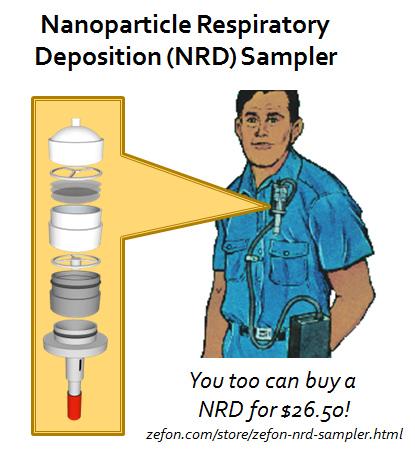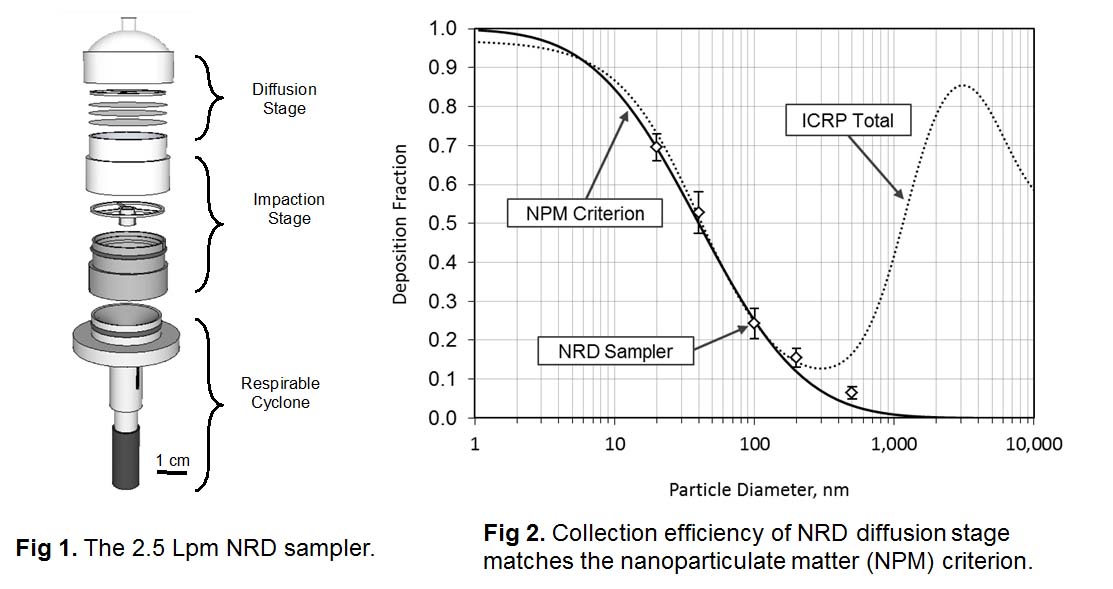

Our nanoparticle respiratory dose (NRD) sampler, initially developed under NIOSH R21, provides a cost-effective means for collecting nanoparticles. As described in Cena et al. (2011), the NRD sampler consists of three primary components assembled in series: a 25-mm respirable aluminum cyclone (Model 225-01-01, SKC Inc., Eighty Four, PA), an impaction stage, and a diffusion stage (Fig 1). Air is drawn through the cyclone, which removes particles larger than the respirable sampler criterion and transports the respirable fraction to the impaction stage, where particles larger than 300 nm are removed. In the diffusion stage, airborne nanoparticlesdiffuse to and are collected onto a stack of mesh screens with an efficiency closely matching particle deposition in the human respiratory tract for particles smaller than 300 nm, which we call the NPM sampling criterion (Fig 2). The sampler is lightweight (~60 g), fits in a standard lapel mount (Model 225-1, SKC Inc., Eighty Four, PA) and operates with a pressure drop of 3.54 kPa (14.2 in. H2O), which is compatible with belt-mounted sampling pumps common to IH.
With further funding through a NIOSH R01, we are developing demonstrated sampling and analysis methods for assessing exposures to metal-based nanoparticles. Two sets of methodology will be developed in parallel in laboratory studies: (Aim 1) new sampling media and higher airflow rates for the NRD sampler to facilitate lower limits of detection; and (Aim 2) analytical methods to detect metal-based particles apart from other aerosols that may be present in workplace air. We will then conduct field tests to demonstrate that the NRD sampler is capable of assessing exposures to metal-based nanoparticles in a variety of environments. All investigators on this project serve in specialized roles that are particularly suited for their expertise: Drs. Anthony and Peters have collaborated to develop the original NRD sampler; Drs. Grassian and Peters have collaborated to examine metal oxide nanoparticle exposures in the workplace. Drs. Anthony and Peters are committed to translating the methods developed in this work to practical tools for the IH practitioner.

Purchase a NRD:
With help from the University of Iowa Research Foundation, NRDs are now made from injected-molded, conductive plastic. You can now by one at Zefon International for less than $30. Click Here.
In the news:
Nov 18, 2013. We recieved R01 support through NIOSH to further develop NRD samplers, develop analytical methods to analyze collected samples, and to field test NRD sampler performance in a variety of environments. More info.